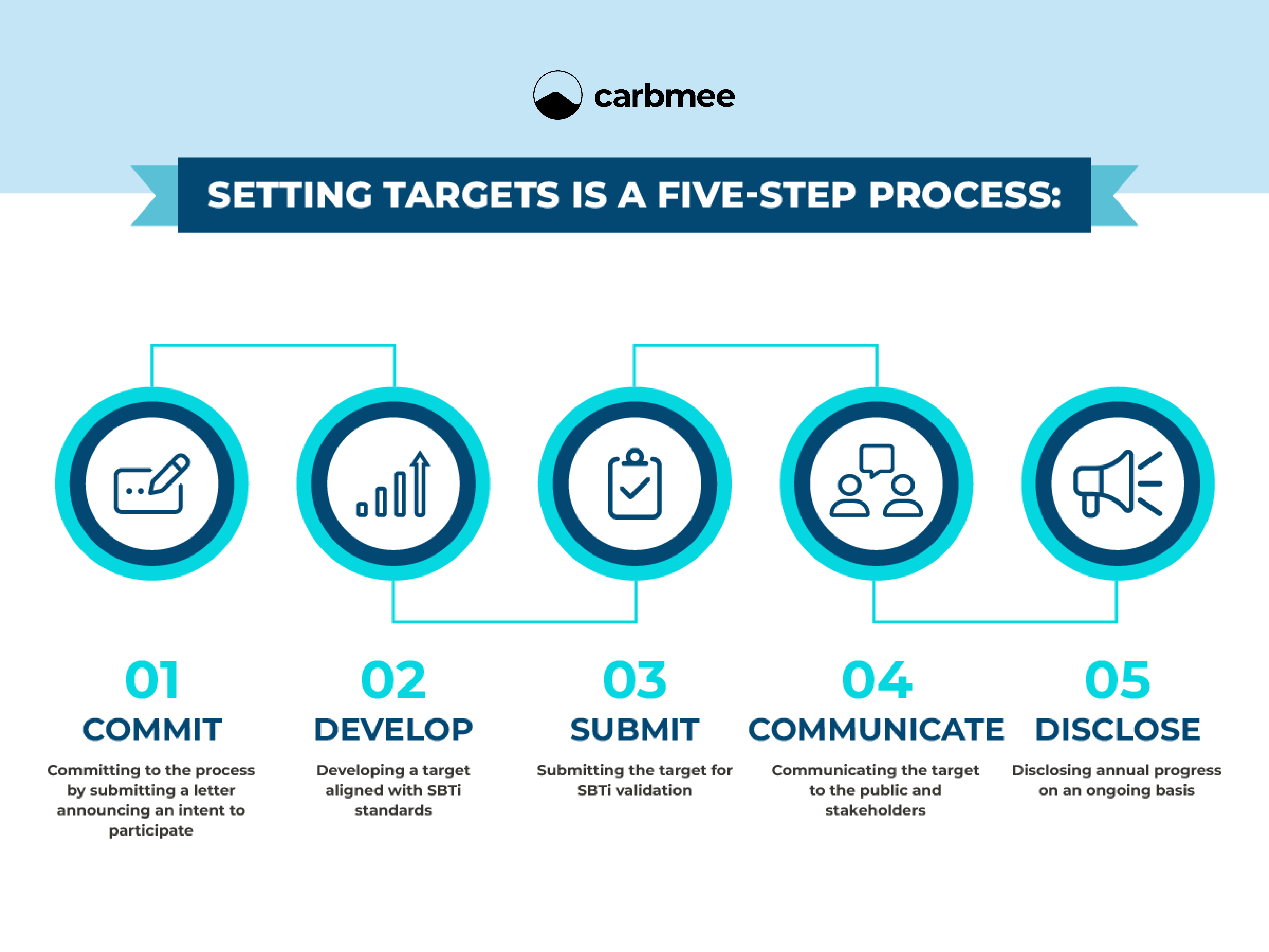Die Science Based Targets Initiative (SBTi)
Die Science Based Targets Initiative ist eine Partnerschaft zur Reduzierung der Co2- Emissionen zwischen CDP (früher bekannt als Carbon Disclosure Project), dem Global Compact der Vereinten Nationen, dem World Resources Institute (WRI) und der World Wildlife Federation (WWF). Diese Partner koordinieren sich mit der We Mean Business Coalition, einer globalen gemeinnützigen Organisation, die mit einflussreichen Unternehmen zusammenarbeitet, um Klimaziele zu verfolgen.
Die Koalition hilft Unternehmen dabei, einen SBTi-Netto-Null-Standard zu erreichen, was bedeutet, dass die Teilnehmer versuchen, die Menge an Kohlendioxid, die sie erzeugen, mit der Menge auszugleichen, die sie entfernen. Die SBTi wurde 2015 ins Leben gerufen, um die Ziele des in diesem Jahr vereinbarten Pariser Klimaabkommens zu fördern.
So funktioniert die SBTi
Die SBTi unterstützt Unternehmen bei der Festlegung und Erreichung wissenschaftlich fundierter Ziele. Dabei handelt es sich um CO2-Emissionsziele, die mit den neuesten wissenschaftlichen Empfehlungen übereinstimmen, um die globale Erwärmung im Einklang mit dem Pariser Abkommen auf unter 2 Grad Celsius über dem vorindustriellen Niveau zu begrenzen. Die SBTi empfiehlt sektorspezifische Emissionsreduktionsziele für bestimmte Branchen wie Öl und Gas, Transport sowie Informations- und Kommunikationstechnologie. Unternehmen können der SBTi Zielvorgaben übermitteln, um Unterstützung bei der wissenschaftlichen Validierung der Ziele und der Verfolgung des Fortschritts zu erhalten. Der Fortschritt wird jährlich verfolgt und öffentlich bekannt gegeben.
Ziele, die von der SBTi festgelegt werden
Die SBTi folgt dem Greenhouse Gas (GHG) Protocol, dem wichtigsten globalen Standard zur Messung von Kohlenstoffemissionen, und unterteilt Treibhausgasemissionsziele in drei Bereiche:
- Scope 1 umfasst direkte Emissionen aus Quellen, die sich direkt im Besitz von Unternehmen befinden, wie Kessel, Öfen und Fahrzeuge
- Scope 2 umfasst indirekte Emissionen aus der Erzeugung des von Unternehmen gekauften Stroms
- Scope 3 umfasst indirekte Emissionen aus anderen Quellen, die sich nicht im Besitz von Unternehmen innerhalb ihrer Lieferketten befinden, wie die Produktion von Materialien, der Transport von Kraftstoff und der Verkauf von Waren und Dienstleistungen
Die SBTi segmentiert Ziele weiter nach anderen Kriterien. Bestimmte Industriezweige haben branchenspezifische Ziele.
Ziele können in absolute und Intensitätsziele unterteilt werden. Absolute Ziele zielen darauf ab, die Emissionen um einen bestimmten Prozentsatz zu reduzieren. Intensitätsziele legen Ziele innerhalb eines Rahmens relativ zu einem wirtschaftlichen oder betrieblichen Parameter fest, wie z. B. die Reduzierung der Emissionen pro Quadratmeter Fläche.
Die SBTi arbeitet mit den teilnehmenden Unternehmen für jedes Ziel zusammen, um einen Emissionsreduzierungsplan zu entwickeln. Dies ist ein langfristiger Plan zur Förderung der Emissionsreduzierung und Nachhaltigkeit.

Welche Vorzüge hat die Festlegung wissenschaftlich fundierter Ziele?
Wie profitieren Unternehmen von der Verfolgung wissenschaftlich fundierter Ziele:
- nachweislicher Beitrag zu den weltweiten Bemühungen zur Bekämpfung des Klimawandels
- Vorsorge für zukünftiges Wachstum
- Senkung der Energiekosten
- Einhaltung gesetzlicher Vorschriften
- Verbesserung der Beziehungen zu Stakeholdern
- Förderung von Innovation und Wettbewerbsfähigkeit
- Aufbau des Images bei den Verbrauchern
Ein weiterer Vorteil ist die technische Unterstützung durch SBTi-Experten bei der Erreichung von Emissionsreduktionszielen und der Entwicklung zu Netto-Null-Unternehmen.
Teilnahme an der SBTi
Die SBTi ermutigt grundsätzlich Finanzinstitute und Unternehmen aller Branchen und Größen zur Teilnahme, wobei ein besonderer Schwerpunkt auf den Branchen mit den höchsten Emissionen liegt. Derzeit gibt es jedoch eine Pause für Unternehmen der fossilen Brennstoffindustrie und Automobilhersteller aufgrund von Veränderungen in diesen Branchen. Kleine und mittlere Unternehmen (KMU) können teilnehmen, indem sie eine vereinfachte Validierung ihrer kurzfristigen und Netto-Null-Ziele beantragen.
Die Festlegung von Zielen erfolgt in einem fünfstufigen Prozess:
- Verpflichtung zum Prozess durch Einreichen eines Briefes, in dem die Teilnahmeabsicht angekündigt wird
- Entwicklung eines Ziels, das den SBTi-Standards entspricht
- Einreichen des Ziels zur SBTi-Validierung
- Kommunikation des Ziels mit der Öffentlichkeit und den Interessengruppen
- Laufende Offenlegung des jährlichen Fortschritts
Teilnehmer an diesem Prozess erhalten Unterstützung von der SBTi und ihren Partnern. Die Unterstützung umfasst:
- Anleitung durch technische Experten der SBTi
- Öffentliche Anerkennung des Engagements für das SBTi-Projekt auf den Websites der SBTi, des CDP, des UN Global Compact und von We Mean Business.
- Zugriff auf digitale Ressourcen wie Anleitungen und Videos, branchenspezifische Richtlinien und wissenschaftlich fundierte Tools zur Zielsetzung
- Eine Bibliothek mit Fallstudien und Veranstaltungen zum Studium als Orientierung
- Ein Newsletter mit laufenden Updates
Für bestimmte Branchen stehen branchenspezifische Ressourcen zur Verfügung. Besonders stark ist die Unterstützung für den Energiesektor und Finanzinstitute mit detaillierten Methoden, Rahmenbedingungen und Anforderungen. Weitere Branchen, die besondere Unterstützung erhalten, sind Bekleidung und Schuhe, Luftfahrt, Chemikalien, Informations- und Kommunikationstechnologie sowie Transport.
Warum Ihr Unternehmen wissenschaftlich fundierte Ziele verfolgen sollte
Die SBTi hilft Unternehmen dabei, wissenschaftlich fundierte Ziele festzulegen und Emissionsziele zu erreichen, die mit aktuellen wissenschaftlichen Empfehlungen und globalen Klimaregulierungsstandards übereinstimmen. Dazu gehören Ziele für direkte Emissionen von Unternehmen und indirekte Emissionsquellen wie Versorgungsunternehmen und Lieferketten.
Unternehmen nehmen an der SBTi teil, indem sie Emissionsziele zur Validierung und kontinuierlichen Verfolgung und Berichterstattung einreichen. Dies fördert die interne Effizienz von Unternehmen und ihre externen Beziehungen zu Regulierungsbehörden, Interessengruppen und Verbrauchern. Genau das wird immer wichtiger, da regulatorische Vorschriften Unternehmen zunehmend zur Emissionsreduzierung verpflichten.
Wenn Sie wissenschaftlich fundierte Emissionsreduzierungsziele verfolgen möchten, stellt Ihnen carbmee Ressourcen zur Verfügung, die Sie dabei unterstützen. Wir bieten eine Cloud-basierte Unternehmenslösung zur Messung des Kohlenstoffgehalts und zur Verwaltung von Emissionen, um Ihre Netto-Null-Ziele zu erreichen. Darüber hinaus bieten wir eine Online-Wissensdatenbank und Antworten auf häufig gestellte Fragen, um Sie bei der Verfolgung wissenschaftlich fundierter Ziele zu unterstützen.
Buchen Sie eine kostenlose Demo unserer Co2- Managementplattform, damit einer unserer Branchenexperten Sie durch unsere Lösungen führt und Ihre Anforderungen bespricht.
![[object Object]](https://images.prismic.io/carbmee/985c5c57-3dab-455d-b0bb-81ce95c04967_pexels-harry-cunningham-harrydigital-3619870.webp?auto=compress,format)





